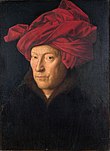
Jan van Eyck was a painter active in Bruges who was one of the early innovators of what became known as Early Netherlandish painting, and one of the most significant representatives of Early Northern Renaissance art. According to Vasari and other art historians including Ernst Gombrich, he invented oil painting, though most now regard that claim as an oversimplification.

The Arnolfini Portrait is a 1434 oil painting on oak panel by the Early Netherlandish painter Jan van Eyck. It forms a full-length double portrait, believed to depict the Italian merchant Giovanni di Nicolao Arnolfini and his wife, presumably in their residence at the Flemish city of Bruges.

Giovanni di Nicolao Arnolfini was a merchant from Lucca, a city in Tuscany, Italy. He spent most of his life in Flanders, then part of the Duchy of Burgundy, probably always based in Bruges, a wealthy trading city and one of the main towns of the Burgundian court. The Arnolfini were a powerful family in Lucca, involved in the politics and trade of the small but wealthy city, which specialised in weaving expensive cloth.
The decade of the 1430s in art involved some significant events.

Portrait of a Man is an oil painting by the Early Netherlandish painter Jan van Eyck, from 1433. The inscription at the top of the panel, Als Ich Can was a common autograph for van Eyck, but here is unusually large and prominent. This fact, along with the man's unusually direct and confrontational gaze, have been taken as an indication that the work is a self-portrait.
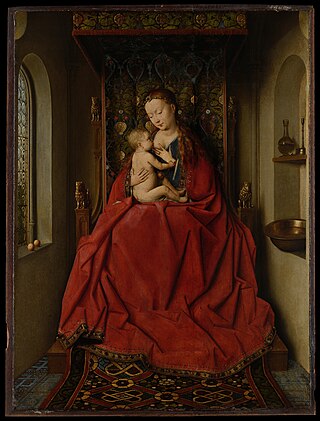
The Lucca Madonna is an oil painting by the Early Netherlandish master Jan van Eyck, painted in approximately 1437. It shows Mary seated on a wooden throne and crowned by a canopy, breastfeeding the infant Christ. Its carpentry suggests it was once the inner panel of a triptych, while its small size indicates it was meant for private devotion. The painting is in the collection of the Städel Museum, Frankfurt.

Saint Luke Drawing the Virgin is a large oil and tempera on oak panel painting, usually dated between 1435 and 1440, attributed to the Early Netherlandish painter Rogier van der Weyden. Housed in the Museum of Fine Arts, Boston, it shows Luke the Evangelist, patron saint of artists, sketching the Virgin Mary as she nurses the Child Jesus. The figures are positioned in a bourgeois interior which leads out towards a courtyard, river, town and landscape. The enclosed garden, illusionistic carvings of Adam and Eve on the arms of Mary's throne, and attributes of St Luke are amongst the painting's many iconographic symbols.

Virgin and Child with Four Angels is a small oil-on-panel painting by the Early Netherlandish artist Gerard David. Likely completed between 1510 and 1515, it shows the Virgin Mary holding the child Jesus, while she is crowned Queen of Heaven by two angels above her, accompanied by music provided by another two angels placed at either side of her. In its fine detail and lush use of colour the work is typical of both David and late period Flemish art.
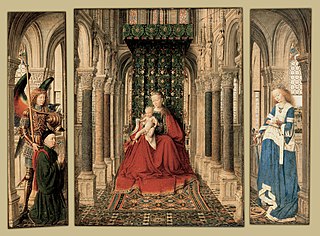
The Dresden Triptych is a very small hinged-triptych altarpiece by the Early Netherlandish painter Jan van Eyck. It consists of five individual panel paintings: a central inner panel, and two double-sided wings. It is signed and dated 1437, and in a permanent collection of the Gemäldegalerie Alte Meister, Dresden, with the panels still in their original frames. The only extant triptych attributed to van Eyck, and the only non-portrait signed with his personal motto, ALC IXH XAN, the triptych can be placed at the midpoint of his known works. It echoes a number of the motifs of his earlier works while marking an advancement in his ability in handling depth of space, and establishes iconographic elements of Marian portraiture that were to become widespread by the latter half of the 15th century. Elisabeth Dhanens describes it as "the most charming, delicate and appealing work by Jan van Eyck that has survived".

The Madonna at the Fountain is a 1439 oil on panel painting by the early Netherlandish artist Jan van Eyck. It belongs to van Eyck's late work, and is his last signed and dated painting. It retains its original frame, which bears the inscription; "ALS IXH CAN", "JOHES DE EYCK ME FECIT + [COM]PLEVIT ANNO 1439

The Virgin and Child with Canon van der Paele is a large oil-on-oak panel painting completed around 1434–1436 by the Early Netherlandish painter Jan van Eyck. It shows the painting's donor, Joris van der Paele, within an apparition of saints. The Virgin Mary is enthroned at the centre of the semicircular space, which most likely represents a church interior, with the Christ Child on her lap. St. Donatian stands to her right, Saint George—the donor's name saint—to her left. The panel was commissioned by van der Paele as an altarpiece. He was then a wealthy clergyman from Bruges, but elderly and gravely ill, and intended the work as his memorial.
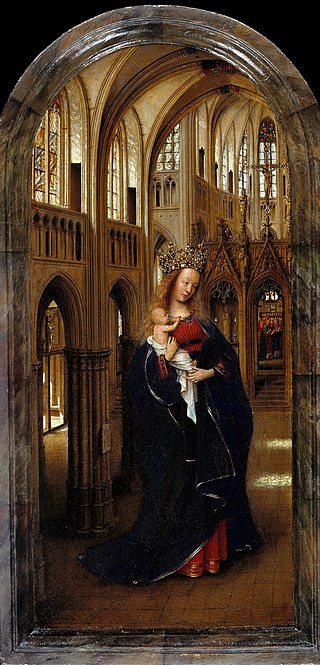
Madonna in the Church is a small oil panel by the early Netherlandish painter Jan van Eyck. Probably executed between c. 1438–1440, it depicts the Virgin Mary holding the Child Jesus in a Gothic cathedral. Mary is presented as Queen of Heaven wearing a jewel-studded crown, cradling a playful child Christ who gazes at her and grips the neckline of her red dress in a manner that recalls the 13th-century Byzantine tradition of the Eleusa icon. Tracery in the arch at the rear of the nave contains wooden carvings depicting episodes from Mary's life, while a faux bois sculpture in a niche shows her holding the child in a similar pose. Erwin Panofsky sees the painting composed as if the main figures in the panel are intended to be the sculptures come to life. In a doorway to the right, two angels sing psalms from a hymn book. Like other Byzantine depictions of the Madonna, van Eyck depicts a monumental Mary, unrealistically large compared to her surroundings. The panel contains closely observed beams of light flooding through the cathedral's windows. It illuminates the interior before culminating in two pools on the floor. The light has symbolic significance, alluding simultaneously to Mary's virginal purity and God's ethereal presence.

Durán Madonna is an oil on oak panel painting completed sometime between 1435 and 1438 by the Netherlandish painter Rogier van der Weyden. The painting derives from Jan van Eyck's Ince Hall Madonna and was much imitated subsequently. Now in the Prado, Madrid, it depicts a seated and serene Virgin Mary dressed in a long, flowing red robe lined with gold-coloured thread. She cradles the child Jesus who sits on her lap, playfully leafing backwards through a holy book or manuscript on which both figures' gazes rest. But unlike van Eyck's earlier treatment, van der Weyden not only positions his Virgin and Child in a Gothic apse or niche as he had his two earlier madonnas, but also places them on a projecting plinth, thus further emphasising their sculptural impression.

Portrait of a Man with a Blue Chaperon is a very small oil on panel portrait of an unidentified man attributed to the Early Netherlandish painter Jan van Eyck.

The Madonna Standing is a small painting by the Flemish artist Rogier van der Weyden dating from about 1430–1432. It is the left panel of a diptych held in the Kunsthistorisches Museum (KHM), Vienna since 1772. The right panel portrays St. Catherine and is also attributed by the KHM to van der Weyden, but is inferior in quality and generally regarded as by a workshop member.
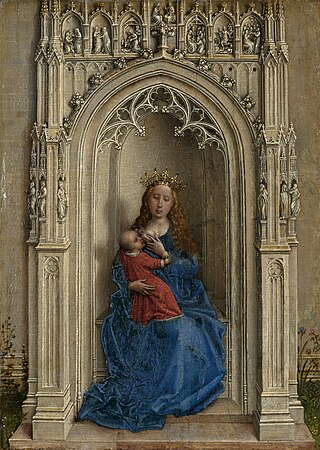
The Virgin and Child Enthroned is a small oil-on-oak panel painting dated c. 1433, usually attributed to the Early Netherlandish artist Rogier van der Weyden. It is closely related to his Madonna Standing, completed during the same period. The panel is filled with Christian iconography, including representations of prophets, the Annunciation, Christ's infancy and resurrection, and Mary's Coronation. It is generally accepted as the earliest extant work by van der Weyden, one of three works attributed to him of the Virgin and Child enclosed in a niche on an exterior wall of a Gothic church. The panel is housed in the Museo Thyssen-Bornemisza in Madrid.
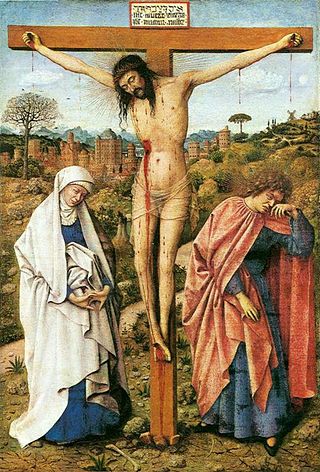
Christ on the Cross with the Virgin and Saint John is an oil on panel painting, later transferred to canvas, attributed to the Master of the Grimacing St John, a senior member of the workshop of Jan van Eyck. It was long attributed to Jan's brother Hubert, based on stylistic similarities to portions of the "Adoration of the lamb" passage in the Ghent Altarpiece. The Master of the Grimacing St John is one of only two assistant of van Eyck's whose hand can be identified across several works. He takes his notname from an imitation stone statue in a grisaille diptych wing panel of St. John the Baptist, opposite a Virgin and Child, and is associated with a pen and pencil drawing of St Paul in Vienna.

Portrait of Giovanni di Nicolao Arnolfini is a small c. 1438 portrait by Jan van Eyck believed to be the same person as in the famous 1434 Arnolfini Portrait due to the similarities of facial features. Thus, the work is van Eyck's second portrait of Giovanni di Nicolao Arnolfini, a wealthy merchant from Lucca, a city in Tuscany in central Italy, who spent most of his life in Flanders. The painting was long thought a self-portrait; in colourisation, costume and tone, it is very similar to the signed and dated Portrait of a Man in a Red Chaperon in London, which is generally accepted as a self-portrait. It was only later that the current work was associated with Arnolfini and the double marriage painting. It is today in the Gemäldegalerie, Berlin.
René Victor Gustave Joseph Sneyers was a Belgian chemist. He succeeded Paul B. Coremans as head of the Institut royal du patrimoine artistique (IRPA).


















